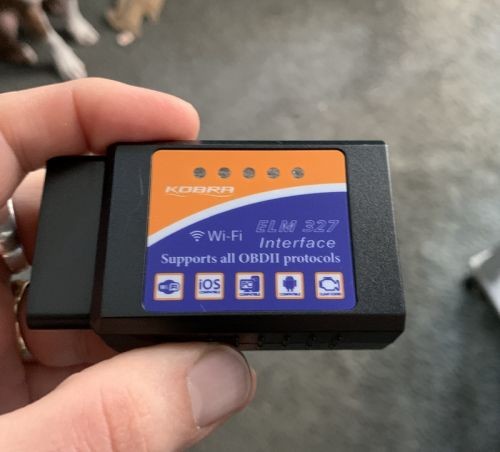Dealing with a check engine light can be frustrating, especially when your car isn’t that old. Like many car owners, facing that dreaded dashboard warning again, I decided to take matters into my own hands. Instead of immediately heading to a mechanic, I explored the world of OBD2 scanners. Recommendations from friends and colleagues pointed me towards these handy tools, suggesting they could decipher error codes and potentially save money by identifying minor issues or sensor glitches. That’s how I landed on the KOBRA Wireless OBD2 Scanner, a budget-friendly option available on Amazon with a substantial number of positive ratings. Promising a vast database of error code definitions and broad vehicle compatibility, it seemed like the perfect entry-level diagnostic tool.
The KOBRA OBD2 scanner, like most of its kind, offers wireless connectivity to your smartphone via either Wi-Fi or Bluetooth. Before diving into app compatibility, let’s talk setup. First, you’ll need to locate your car’s OBD-II port. It’s usually under the dashboard on the driver’s side. If you already use a device that plugs into this port, such as for insurance tracking, you’ll need to temporarily disconnect it to use the KOBRA scanner.
Installation is straightforward – simply plug the KOBRA scanner into the OBD-II port. Once connected, it powers on and is ready to link with your smartphone. This particular KOBRA model uses a Wi-Fi connection. To establish this, you need to go into your phone’s Wi-Fi settings and select the OBD2 reader’s network.
While I only tested the Kobra OBD-II reader on my 2008 vehicle, the product description advertises compatibility with all car models from 1996 to 2016 and states it can retrieve both generic and manufacturer-specific Diagnostic Trouble Codes (DTCs). The claim of supporting numerous mobile apps, including popular ones like OBD Fusion, DashCommand, Torque, and others listed on both the Apple App Store and Google Play Store, initially seemed promising. However, my experience revealed a different reality.
I discovered that the app compatibility is not as broad as advertised. Many OBD-2 apps are designed to work exclusively with specific scanners, often Bluetooth-based models. Popular apps like Garage Pro, FIXD, AutoDoctor, and Torque, among others, failed to recognize or connect to the KOBRA Wi-Fi scanner. In fact, the only app I found to be reliably compatible on iOS was Car Scanner ELM OBD-2. While other apps might potentially work, be aware that many favor Bluetooth connections over Wi-Fi for OBD-II scanners.
The Car Scanner ELM OBD-2 app thankfully offered a Wi-Fi connection option, which worked seamlessly with the KOBRA scanner using the default IP address and port settings. After successfully connecting the KOBRA OBD-2 Scanner and the Car Scanner Pro app, a range of diagnostic options become available. These include real-time dashboards, live sensor data, comprehensive sensor readings, and crucially, diagnostic trouble codes – the key to understanding that pesky check engine light. Before delving into the error codes, let’s take a quick look at some of the other informative dashboards.
The app provides real-time data on vital engine parameters such as RPM, speed, and coolant temperature. This live data stream can be helpful for monitoring your car’s performance.
Furthermore, the app tracks trip statistics like driving time, fuel consumption rates, and overall fuel usage. This information can be valuable for fuel efficiency analysis and trip tracking.
You can also monitor your car’s battery voltage through the app, which is useful for assessing the health of your car’s electrical system.
When I checked for error codes, the KOBRA scanner and app revealed codes P2004, P0128, P0522, and P0856. The P0856 code turned out to be an irrelevant “inhibited test” reading. After clearing the codes to see which would reappear, the persistent culprit was P2004, indicating an “intake manifold air control actuator stuck open” issue. Researching this code provided not only a clear understanding of the problem but also estimated repair costs from various sources.
This knowledge empowers you when you visit a car repair shop. By having pre-scanned your car, you can compare your findings and estimated costs with the mechanic’s diagnosis. This allows for more informed discussions and the potential to shop around for better repair quotes if needed. While the KOBRA OBD2 scanner didn’t magically fix my car, it gave me valuable insight into the problem and allowed me to manage the repair timeline and budget more effectively, as the issue wasn’t immediately critical.
The KOBRA OBD-II Scanner is available on Amazon for a budget-friendly price of around $20.99. Despite the app compatibility limitations, it offers significant value for its price. The primary drawback is the misleading claim of broad app compatibility, which required some trial and error to find a suitable app. However, for basic OBD2 diagnostics, reading error codes, and gaining insights into your car’s health, the KOBRA scanner is a worthwhile investment, potentially saving you significantly more than its cost in the long run by avoiding unnecessary trips to the mechanic for simple diagnostics.
[
